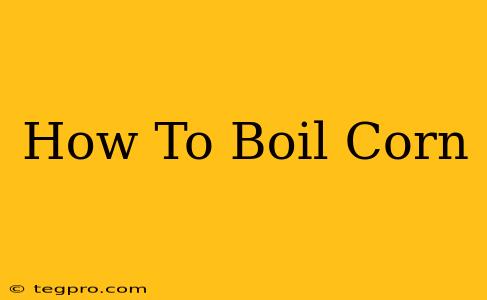Boiling corn on the cob is a surprisingly simple process that yields incredibly sweet and tender results. Whether you're preparing a summer barbecue, a family dinner, or just a quick and delicious side dish, this guide will walk you through the steps to perfectly boiled corn every time. Let's get started!
Preparing Your Corn
Before you even think about boiling, you need to prepare your corn. Here's what you'll need:
- Fresh Corn on the Cob: Choose ears of corn that are plump, firm, and have tightly-packed kernels. The silks should be relatively dry and brown, not wet and green.
- Large Pot: Make sure your pot is large enough to hold the corn comfortably, with enough water to cover the ears completely.
- Water: Plenty of fresh, cold water is crucial for even cooking.
- Salt (Optional): A little salt enhances the corn's natural sweetness.
Husking Your Corn
This is where things get personal. Some people prefer to leave the husks and silks on during boiling, which helps to retain moisture. Others prefer to remove them completely. There are pros and cons to each method:
Leaving the Husks On: This is a great method for preserving the corn's natural sweetness and moisture. Just be sure to remove any stray silks before boiling.
Removing the Husks: This gives you better control over the cooking process and allows for even cooking. Simply pull back the husks and remove the silks. You can also cut off the stem end.
Boiling Your Corn: Step-by-Step
Once your corn is prepped, follow these easy steps:
- Fill the Pot: Fill your large pot with enough cold water to cover the corn completely. Add a generous pinch of salt, if desired. Adding salt to the water before the corn ensures even seasoning.
- Add the Corn: Gently place the prepared corn cobs into the pot.
- Bring to a Boil: Over high heat, bring the water to a rolling boil.
- Reduce Heat and Simmer: Once boiling, reduce the heat to medium-low, maintaining a gentle simmer.
- Cook Time: The cooking time depends on the freshness and size of your corn. Generally, young, tender corn will take 5-7 minutes, while older corn may require 8-10 minutes. Test the corn's tenderness by piercing a kernel with a knife or fork. It should be easily pierced but still slightly firm.
- Drain and Serve: Once cooked, carefully remove the corn from the pot using tongs and drain any excess water. Serve immediately with your favorite butter, salt, pepper, or other seasonings.
Tips for Perfect Boiled Corn
- Don't Overcook: Overcooked corn becomes mushy and loses its flavor. It's always better to slightly undercook than overcook.
- Fresh is Best: While frozen corn is a convenient option, fresh corn offers the best flavor and texture.
- Experiment with Seasonings: Get creative! Try adding herbs like cilantro, chives, or thyme to the boiling water for an extra flavor boost. A squeeze of lime juice after cooking also adds a refreshing touch.
- Grill It After Boiling: For a smoky, slightly charred flavor, grill the boiled corn for a few minutes after cooking.
Beyond Boiling: Other Cooking Methods
While boiling is a classic method, you can also cook corn using other techniques, including:
- Grilling: Grilling corn in the husk is a fantastic way to add a smoky char to the kernels.
- Steaming: Steaming corn produces tender, flavorful results similar to boiling.
- Microwaving: For a quick and easy method, you can microwave corn on the cob.
Following these simple steps and tips, you'll be able to enjoy delicious, perfectly boiled corn every single time. Enjoy!

